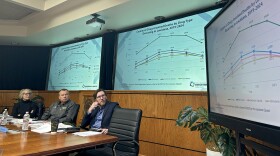The A/C hums in the background on a hot August morning as Danovan Calhoun Bettis does laundry and texts his bandmates. The leader of a brass band, Bettis and 3rd Degree, is coordinating schedules and upcoming gigs, which always slow down in the summer.
Bettis is a textbook example of a New Orleans musician. He grew up in the city’s Seventh Ward, started playing the drums in church when he was 10, became head drum major of the famous “Marching 100” band at St. Augustine High School and started his first of many brass bands soon after graduating.
He remembers being hot while marching in parades at “St. Aug,” sweating beneath the heavy uniform and helmet, and carrying a drum for miles. His passion for playing music hasn’t changed, but he says the heat is different now.
“It’s bad, man. It’s way worse,” Bettis said. “We've had hot summers, especially growing up here, you expect it to get hot. But now it feels like the sun is right above us.”
Bettis is right. Climate scientists tracking the city’s weather patterns say average annual temperatures have risen about 3 to 4 degrees over the past century, with most of the steep increases happening in the last few decades.
The summers in New Orleans have gotten more than 4 degrees hotter than they were in 1970, according to research from Climate Central, an independent climate research organization.
“In most places, that’s where you really see the big jump — in the last 20 to 30 years,” said Jen Brady, a senior data analyst at Climate Central.
Can’t see the interactive chart below? Click here.
Data can fluctuate, and some summers can be hotter than others. The year-to-year swings in temperature data are referred to as “noise” by scientists. But like static in a radio broadcast, the noise in the data doesn’t drown out the “signal,” or the long-term climate trend beneath it.
Cut out the noise, and the signal is clear: in New Orleans, the heat is turning up and the rate at which it’s increasing — the temperature tempo — is getting faster. These higher levels of heat are affecting people’s health and changing the way they live and work.
Daniel Smith, trumpeter for Bettis and 3rd Degree, said a decade ago he could play all day in the summer. Now it’s “unbearable.”
"You can hear it in the music" when a band is overheated, said saxophonist Matt Thomas. The music dulls, and dehydration makes certain tasks harder, like forming the embouchure — the shape of the mouth needed to play wind and brass instruments.
‘We’re seeing a new trend’
New Orleans has always been hot, Brady said. And noise in the temperature data includes fluctuations reflecting the difference between short-term weather and long-term climate. But the data also show a sustained increase in temperature.
“We’re seeing a new trend,” Brady said. “It’s levels that we’ve never seen before.”
The increase in temperature is due to an increase in greenhouse gas emissions, Brady said. Those gases accumulate in the atmosphere, forming a “blanket” that traps and holds heat. Over time, human activity, such as burning fossil fuels, deforestation, industrial processes and agriculture, adds more and more greenhouse gases — thickening the blanket.
Those gases can linger. Even if all emissions were stopped today, Brady said, scientists expect temperatures to continue to rise over the next few decades.
An increase of a few degrees in average annual temperature may not seem significant, Brady said, and noise in the data can obscure the trend.
That’s why Climate Central creates visual representations — charts, graphs, and maps — to convey the data, even if people who live and work in places where it’s getting hotter, like musicians in New Orleans, can already feel the difference.
“We need everyone to understand,” Brady said. “I often say to people, ‘I’m not really telling you anything you don’t know. I’m just providing you the data to support what you know.”
Can’t see the video below? Click here.
Heat’s impact on the body
Higher temperatures aren’t just uncomfortable, they’re dangerous.
But heat can be deceptive, Brady said, because it doesn’t have the “visual, all-encompassing impact” of things like hurricanes — something New Orleans is intimately familiar with.
But heat kills more people than any other weather event, including floods and hurricanes. In Louisiana, 51 people died from heat exposure in 2024, and more than 6,000 went to the hospital for heat-related illness.
Street musicians in New Orleans often have a front-row seat for how the heat impacts people. Adam Lessnau, a trombone player who often performs in Jackson Square in the French Quarter, said he’s seen both tourists and musicians pass out, “overwhelmed by the heat.”
Extreme heat stresses the human body at a fundamental level, down to the DNA.
“When we’re exposed to high heat, our bodies work hard to regulate internal temperature,” said Dr. Mostafijur Rahman, a heat health researcher at Tulane University’s School of Public Health and Tropical Medicine. “We sweat more, and blood flow shifts toward the skin to release heat. But this can raise the risk of dehydration, heat exhaustion, and heat stroke.”
The impacts don’t stop there. Prolonged or repeated exposure to extreme temperatures can harm the body in deeper ways, leading to what scientists call oxidative stress.
“Heat stress increases reactive oxygen species — unstable molecules that can damage cells, proteins, and DNA,” Rahman said. “Over time, that can contribute to cardiovascular disease, respiratory problems and neurodegenerative disorders.”
Certain groups face greater risk, Rahman said, including older adults, children, pregnant women and people who live and work outside, like musicians.
There are also compounding stressors in certain pockets of the city. More than three-quarters of New Orleanians live in “urban heat islands,” where concrete and a lack of shade can make temperatures feel 9 degrees hotter, according to research from Climate Central.

In Treme, one of the oldest Black neighborhoods in the country and often considered the birthplace of jazz, residents not only endure heat islands and high humidity, but also face noise and air pollution from the I-10 Claiborne Expressway that runs through it.
These risks don’t end when the sun goes down. Average nighttime temperatures are rising even faster than daytime heat in New Orleans, making it harder for people to cool off and recover.
“Each of these exposures can raise blood pressure, disrupt sleep, and affect our health,” Rahman said. “Exposure to high heat can also affect our mental health because it disrupts our sleep, it disrupts our psychological response and outdoor activities. So that can affect our mental well-being as well.”
‘We have to take the gig’
In addition to being a drummer, Bettis is a “culture bearer” in New Orleans — someone who’s dedicated to preserving and maintaining the city’s unique traditions.
He’s also director of engagement at the Music and Culture Coalition of New Orleans (MaCCNO), a nonprofit that advocates for the city’s musicians. A survey done by the group found the average pre-pandemic annual income for the city’s musicians was just under $28,000 per year.
The group is pushing for a minimum wage or a standard pay rate for musicians, as many are struggling to pay bills, buy groceries and — like Bettis — don’t have health insurance.
The temperature may be increasing, but the demand for them to play is constant.
“The drive for us to continue to do what we do is always going to be there,” Bettis said. “But the conditions that we do it in, we really don't have a say over. We have to take the gig.”
He hates to use the word “resilient” — an adjective he said is too often used to describe New Orleanians in the aftermath of a tragedy — but he said it’s accurate.
“The priority of survival outweighs the conditions,” Bettis said. “However, the conditions play a very big role in the longevity of the survival that we're trying to do.”
This story was produced by the Gulf States Newsroom, a collaboration between Mississippi Public Broadcasting, WBHM in Alabama, WWNO and WRKF in Louisiana and NPR. Support for public health coverage comes from The Commonwealth Fund.













